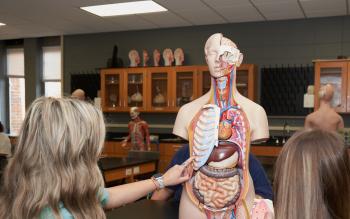Anatomy of Success: How One Professor's Method Skyrockets Student Success Rates
May 29, 2024 | Payton Potter | Faculty Spotlight, Student Success

CHATTANOOGA, TN -- When it comes to inspiring student success, one Chattanooga State Community College professor is rethinking classroom management, class size, teamwork, and camaraderie to increase success rates and better prepare students for the workforce.
Bobbie Meyer, Sciences Department Head and Associate Professor, teaches anatomy and physiology at ChattState, which is attended by biology and nursing students. With years of teaching experience, Meyer saw an opportunity when the college began offering widespread 7-week classes after the COVID-19 pandemic.
In shifting from traditional 15-week anatomy and physiology courses to 7-week formats, Myers integrated lectures and labs into one class sitting, reduced class sizes, and pushed students into collaborative working groups called “learning communities.” She observed a marked increase in success rates and a decline in student withdrawals.
Traditionally, anatomy and physiology classes were conducted in 15-week modules with separate lectures and labs, often led by different instructors, meaning some students learned different concepts at different times, she said.
In redesigning how she delivers her anatomy and physiology courses to fit a 7-week framework, Meyer focused on four non-negotiable things: integrating lab and lecture into one class, limiting enrollment to 24 students per course, conducting all courses in laboratory classrooms, and meeting for 3 hours a day, four days a week.
Student success is defined as finishing a class with an A, B, or C. On average across four semesters, Meyer found that 15-week anatomy and physiology courses saw a success rate of 64.5 percent.
Students taking integrated 7-week combined classes, however, averaged a success rate of 91.75 percent.
Meyer’s research also found that students in 15-week classes with separate labs and lectures withdrew from their course at a rate of 9 percent while 7-week students in integrated classes withdrew at a rate of only 2 percent.
Integrated anatomy and physiology classes are capped at 24 students, allowing instructors to more easily attend to individual students while teaching them to rely on one another.
Each day during class, Meyer said, students work and study together — going as far as to take group quizzes together. Students often create study groups and spend time together outside of the classroom.
“They’re regulating themselves and are responsible to each other,” she said. “They set up study times outside of class. I’ve been very surprised at how well they work together.”
Pushing students to work in learning communities also prepares them for teamwork in the workforce.
"Learning communities are a way to practice professionalism by working together and communicating with one another," she said.
Starting this semester, every single in-person anatomy and physiology course at ChattState will be taught in an integrated format with a limit of 24 students per course, she said.
“Your lecture and lab are combined. You will have the same instructor,” she said. “It’s going to be more hands-on, more personable. No one will feel lost in a sea of students”
Meyer's forward-thinking approach epitomizes the innovative spirit of ChattState, rethinking educational approaches to instill students with the indispensable skills of collaboration and communication essential for thriving in today's dynamic workforce.
